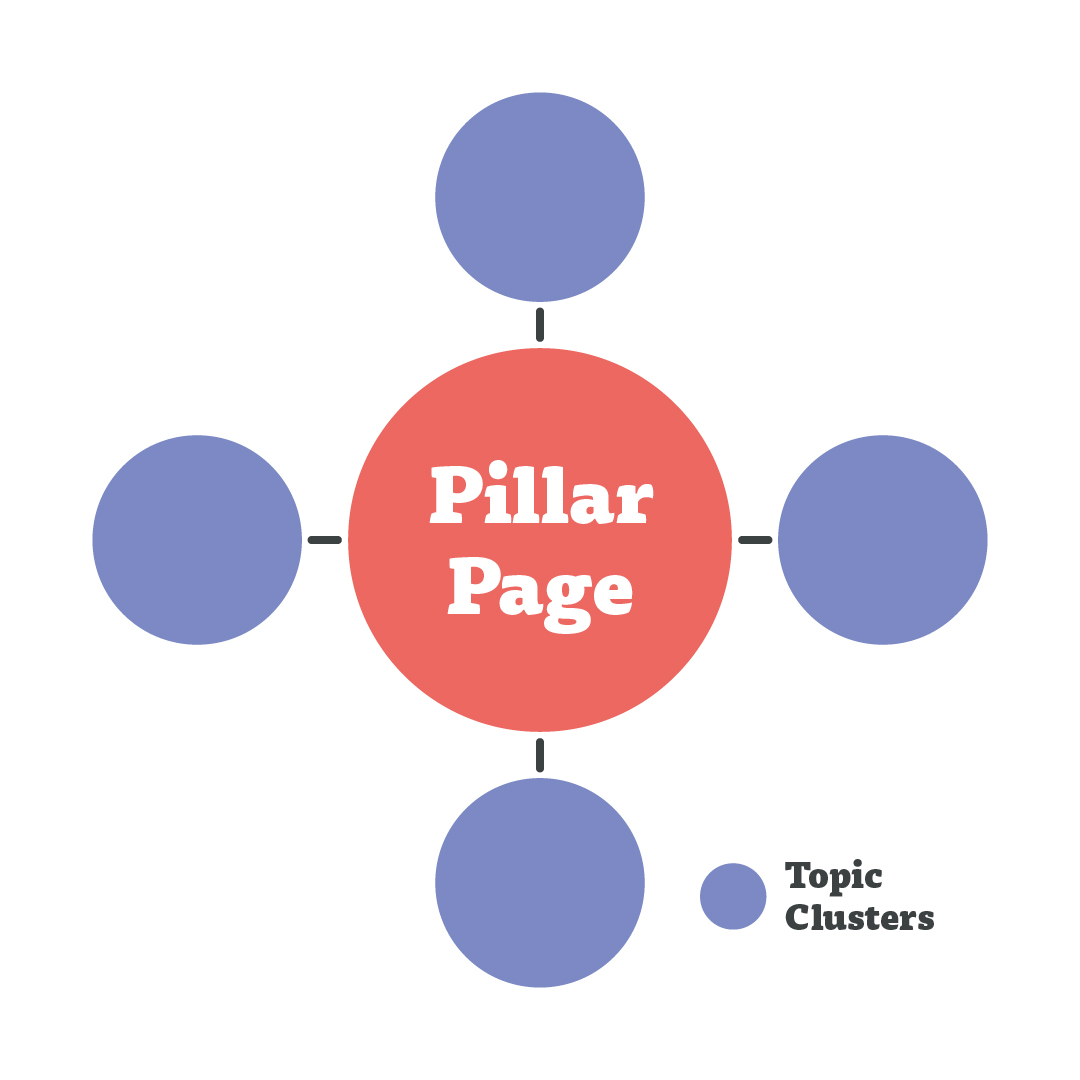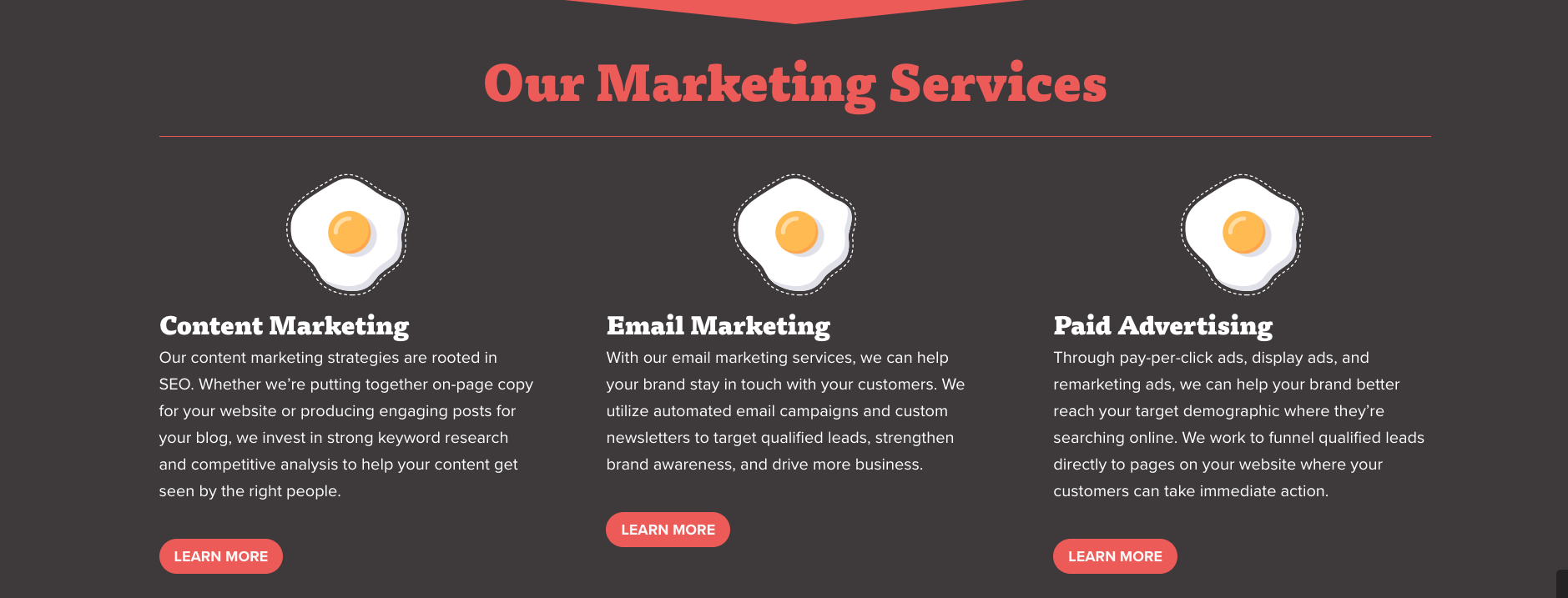Struggling to reach an audience with your website content? An effective part of any content marketing strategy is to create topic clusters, which can help increase your search engine visibility to potential customers. Read below to learn more about what SEO topic clusters are and how they can be used to improve your digital marketing efforts.

What Are Topic Clusters?
Topic clusters, also known as hub and spoke pages or content clusters, are a group of connected pages that all link back to one central pillar page as a content marketing tactic to improve a website’s SEO.

A topic cluster content strategy is used to establish your brand as an authority on a given subject to both search engines and your audience. Part of the topic clustering process includes creating in-depth landing pages that cover ideas related to your business or subject matter expertise. This can help you target a wide range of relevant keywords while also organizing website content in a way that makes it easier for site visitors to find and consume. Though topic clusters can consist of many pages and subpages, there are typically two main components: pillar pages and cluster pages.
Pillar Pages
The first level of a topic cluster is the pillar page. Pillar pages, also called hub pages, are effective website landing pages that provide a broad range of information surrounding a topic. Their main purpose is to be an easy-to-navigate information hub that compiles several cluster pages (aka. subtopics) together.
Because pillar content serves as a high-level introduction to a main topic, you can easily demonstrate your content authority on the subject to readers and search engines. Their strategic internal linking structure also entices users to click through your website for a more in-depth view on specific subtopics—a positive SEO signal.
Cluster Pages
Cluster pages are the second level of a topic cluster. Your pillar pages will link to many cluster pages with related subtopics. These subtopics help you build authority and give you more opportunities for internal linking and keyword clustering.
Cluster pages should always have more detailed content than what’s available on the pillar page. They also need to link back to their hub page with rich anchor text. This helps Google understand your website’s hierarchy. It’s okay for cluster pages to link to second-level pages within the same topic cluster, or even those from a different topic, but they should never link to a pillar page of another cluster. That way, search engines understand your website’s architecture and appropriately spread page ranking throughout clusters.
Topic Cluster Example
Think of pillar pages like an introduction and table of contents in a book and cluster pages like the individual chapters. A great topic cluster example is the Hurrdat Marketing services page.

This pillar page broadly covers topics like email marketing, content marketing, web design, and other digital marketing services. Then, the page provides links to the more focused subtopic pages, where users can receive more specific details about each service’s process, pricing, and more.
What’s the Value of Using Topic Clusters?
Using topic clusters as part of your website’s content marketing plan helps showcase your knowledge, organizes your website content, and provides useful information for site visitors. But that’s not all topic clustering can do for your website. Read on to learn more about topic clustering’s positive impacts on SEO, sales efforts, and more.
Better Keyword Optimization
Topic clusters help you improve your website’s keyword optimization. Because topic clusters allow you to break down a subject into focused subtopics, you can target unique keyword clusters.
For example, if your main topic is “catering services” with catering as the main keyword, you can build out cluster pages that cover more specific catering options around keyword variations like event catering, wedding catering, and corporate catering.
Having these keyword variations built around the main keyword in your website optimization strategy strengthens your overall keyword usage, which, in turn, can help your website show up in search engine results while avoiding keyword cannibalization.
Stronger Internal Linking
Internal linking is exactly as it sounds—links that go to pages within your website. By utilizing the hub and spoke content model for your webpages, you can improve internal linking across your website. Connecting top-level pages (those typically found in your website’s main navigation) to deeper pages (those that may not be found in the main navigation) makes it easier for search engines to find your content, understand the hierarchy of these pages, and spread link equity. A strong internal linking framework is more likely to keep site visitors clicking through to more webpages, which is also a positive SEO signal.
Improved Sales Funnel
With comprehensive SEO topic clusters, you can take a customer who lands on your website from an awareness point to a consideration point, and finally to a conversion point. In other words, you introduce information to them, lead them to more specific content, and then drive them to make a purchase, send a message, fill out a form, or call your business.
You can even spread this sales funnel approach out over the course of multiple pages so that the sale lead-up feels natural. Use keyword research to help make sure your content captures interest at the top, middle, and bottom of the sales funnel.
Richer Content
One big advantage of creating topic clusters for your website is that it allows you to develop high-quality content. Rather than building a single “information dump” webpage, you can break up content into more digestible pieces, which makes for a better user experience and gives you more room to dive deeper into certain subjects. And the better, more detailed your content is, the more likely you’ll earn topical authority, which can help you gain backlinks for your website.
How to Create Topic Clusters
Below are the steps you should take if you’re considering using a topic cluster strategy on your website.
1. Identify Industry-Related Topics
Ever since Google’s Hummingbird update in 2013, content strategy has shifted from a strict focus on keywords to gaining topical authority on a given subject. That means you should only be writing about topics that directly or closely relate to your industry.
For example, if you’re a credit union, your direct topics could be your services like savings accounts, business loans, and home loans. One closely related topic might be the homebuying journey in order to target top-of-funnel readers into applying for your home loans. But you’d never want to stray beyond second-degree topics.
By “staying in your lane,” you’re helping search engines narrow down field of expertise and which search queries your website should appear in. This can positively affect your search engine rankings, and potential customers will more likely consider you for their solution.
Here are a few questions to ask when crafting a topic cluster content strategy:
-
- Which topics are relevant and important to your brand?
- Which topics have worked well for you in the past?
- What content do you already have?
- Which topics does your target audience care about?
- What do customers buy your product for?
Once you know these answers, you can create topic clusters that position your product or service as the solution to your customers’ pain points.
2. Conduct Keyword Research
Your pillar pages are high level, so their keywords should also be broad. On all your webpages, you should use main keywords. Only as you write your cluster pages will you want to get more specific, with long-tail and related keyword types.
To complete thorough keyword research for your topic clusters, find a comprehensive keyword research tool that shares search volume, keyword difficult, and related phrases that could generate subtopics for other related cluster pages.
3. Create a Topical Map

An SEO topical map is a visual representation of your main topic and all its related branches. It’s a blueprint for your website hierarchy and internal linking framework. You should use a topical map to identify which ideas work best as hub pages and which are better as cluster pages. It’ll also reveal any gaps in your content plan.
4. Write Quality Content
Start with your pillar page content because it’s broad, less time-intensive, and will be needed before your cluster pages if you want to set up proper internal linking. Then, write your more focused cluster pages, working in internal links to the pillar page and linking related cluster pages with each other.
Throughout your content creation process, keep in mind that while you want your content to be picked up by search engines, your pages should be made for a human audience. So, always answer readers’ questions, engage them, and give clear calls to action (CTAs) to convert them into customers.
5. Evaluate & Refine Content
As you continue with your topic cluster creation process, set key performance indicators to measure your content’s success. There are several important website metrics to track, such as total session time, conversion rates, bounce rates, and more.
Using metrics can help you determine which aspects of your topic clusters worked, which didn’t meet expectations, and what content needs to be reoptimized.
The amount of time you should wait for a page’s performance results depends on the type of content you’re evaluating, whether that be a single cluster page, blog post, or the entire website itself. Generally, the industry standard for evaluating and updating pages ranges from three to nine months. After that time period, if your pages are underperforming, it’s a good idea to refresh your content.
Want to develop effective topic clusters on your website? With web design, search engine optimization, and content marketing services, Hurrdat can help you build topical authority and convert more customers. Get started today!



